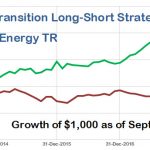EnviroStar: A Clean Laundry Stock For Your Portfolio
Saj Karsan EnviroStar (EVI) is a distributor of laundry equipment that has developed a proprietary dry-wet-cleaning machine that avoids the use of perchloroethylene (Perc), a harmful chemical that the International Agency for Research on Cancer has deemed a carcinogen. Perc is also classified as a hazardous air contaminant by the US Environment Protection Agency, and its use will become illegal in the state of California in the year 2023. EnviroStar's patented Green-Jet process uses an environmentally-friendly, water-based solution that is both non-toxic and requires less energy consumption than traditional dry-cleaning methods. This is currently a tiny company, with...
Cleantech Venture Capitalists are Human Too
David Gold Sectors like solar, biofuels and smart grid have received a significant overweighting of venture capital investment compared to other sectors. Is this because they are better investment opportunities or because venture capitalists (VCs), being human, invest in what they know and who they know? While many entrepreneurs may not believe it, VCs are human, too. In my last post, “Human Capital, Not Venture Capital, the Biggest Cleantech Need,” I discussed how the greatest challenge today to growing a successful early-stage cleantech business is the shortage of successful, experienced cleantech entrepreneurs. But finding the right...
How Likely Is A Big Rally For Alt Energy Stocks?
Last week, Jefferies & Co. held its Global Clean Technology Conference. Unsurprisingly, the tone wasn't as optimistic as in previous years, with cash and funding worries top of mind. Nearly two months ago, I discussed some tangible signs pointing to looming problems in the industry. However, despite all the gloom, it seems as though several firms (and investors!) are expecting the American Reinvestment and Recovery Act (ARRA) to provide the industry with a lifeline. But will this really be the case? For one thing, the major environmental spending programs in the ARRA are relatively...
Green Energy Investing For Beginners: Index
Tom Konrad, CFA I write about investing in Renewable Energy, Energy Efficiency, and other green technologies because I'm worried. I'm worried that the inevitable transition away from fossil fuels driven by peaking supply and climate change could be much more painful than it needs to be because, as a society, we have massively underinvested in the infrastructure that we will need for the transition. I don't care if my readers are motivated by an altruistic wish to make the world a better place, or they just want to cash in on what promises to be the hottest stock market...
ESG5 Summit brief
A conference hosted in NYC in early April, 2019 ESG5 SUMMIT showcased the issues of current concern to institutional asset managers. ESG as a term is a rebranding of SRI (socially responsible investing) and CSR (corporate social responsibility) now under broad headings of Environment Social & Governance, to reflect that it is more than just an investing style, but is concerned with risk management and value creation. ESG strategies are being pursued by a range of participants, including public and private pension funds, mutual funds and ETFs, family offices and sovereign wealth funds, and advisors and advocacy groups.
The goals are...
Bearing The Interest Burden
by Debra Fiakas CFA Smaller companies frequently avoid debt as a capital source, relying instead mostly on equity. After all common stock holders are often content to wait for years for a dividend as the small, young company secures its market position and builds profits. Pesky creditors are always knocking on the door for interest payments and principal return. Yet, a number of smaller companies included in our Beach Boys Index of alternative fuel producers have chosen to use debt. We reviewed a group of them to determine the impact of increase in interest rates that could...
Richard Rhodes, “Energy: A Human History”
Richard Rhodes has written an amazing book. He aspired to tell the tales of energy transitions over the past 400 years. His Energy: A Human History accomplishes that task.
The book is daunting in size for non-required reading. It is filled with brief stories of this or that device or discovery or development, and almost overwhelming in both scope and detail. I wondered, at times, when the payoff would come.
My advice: If you are at all interested in the topic, stick with it.
To my economics-trained mind the book lacks analytical structure. One story after another, linked together by fuel source or technology, layer...
REDI-ing Your Portfolio for a Low-Carbon Economy
Tom Konrad, CFA Colorado's recently released Renewable Energy Development Infrastructure (REDI) report looks at what the resource-rich state needs to do to accomplish the state goal of reducing CO2 emissions 20% from 2005 levels by 2020. Investors who expect the developed world to attempt similar cuts in emissions should take note of the report's conclusions, and invest accordingly. Since Colorado Governor Bill Ritter recruited my friend Morey Wolfson for the Colorado Governor's Energy Office (GEO) he's had a lot less time to socialize with the rest of us in the clean energy community, but we caught up over lunch...
SEC Charges Chinese Units of Five Accounting Firms; Chinese Cos Defect
Doug Young Media are buzzing with word that the US securities regulator is once again tussling with major auditors over access to the accounting records of US-listed Chinese firms, in the latest chapter of an ongoing story; but what has me more intrigued is the scramble that is probably taking place behind the scenes, as those same auditors try to figure out what they will do when the inevitable happens and they are forced to share their records with the US Securities and Exchange Administration (SEC). Right now I can imagine what is happening: the auditors, including big...
Graphene From Plasma
by Debra Fiakas CFA The corporate literature of Haydale Graphene Industries, Plc. (HAYD: AIM) says graphene material could ‘revolutionize the 21st century.’ Unfortunately, finding an economical way to produce graphene has had some wondering if we might have to wait until the 22nd century to finally gain the benefits of graphene’s numerous superior qualities of strength, flexibility and conductivity. Based in the U.K., Haydale reported an eight-fold increase in sales of its graphene materials in the last six months of 2014. Granted revenue totaling GBP482,000 (USD$737,460) is still small, but the growth lends new credibility to...
Our Investments Matter
The stocks and mutual funds we own have a real effect on the behavior of the companies we choose (not) to invest in.
The Ontario Feed-in Tariff For Alternative Energy
Last month, I wrote about how Ontario, North America's 6th largest jurisdiction by population, had tabled a Green Energy Act to boost the alternative energy industry's growth in the province. In that post, I mentioned that officials would soon release the rules for a feed-in tariff (FIT) system. FITs, which pay fixed rates for renewable power, are all but absent in North America, although they are popular incentive in Europe. Germany's FIT is largely responsible for that country's dominance in solar PV today despite mediocre sun conditions. Ontario released the draft rules and proposed prices for...
Alternative Energy Will Outperform The Market, With Storage Stocks Leading the Way
The public relations firm Waggener Edstrom released a survey of investors and analysts yesterday seeking opinions on what was in store for alternative energy for 2009 (link to the survey at the end of this article). Of the 81 respondents, 47 were institutional investors, 26 were brokerage analysts, five were from independent research firms and three were classified as "Other industry participants". Overall, 58% of respondents were from the buy side, 32% from the sell side and the remainder from "Other". Here are a few tidbits that caught my attention. Storage: The Next Boom? Overall, 50% of respondents expect...
Sprott’s Peak Oil Watch
While browsing the web this morning, I came across a very interesting section on Peak Oil on Sprott Asset Management's website (best viewed with Explorer). Sprott Asset Management is a Toronto-based boutique investment management company that I consider, for lack of a better term, pretty cool. They have taken some relatively unorthodox commodities bets in the past and have often won them. For instance, they spotted the bull market in uranium very early on and did well as a result (PDF document). There are many web-based Peak Oil resources out there, so you may wonder why I decided...
Alternative Energy Stocks In 2013: Winners And Losers
By Harris Roen Alternative energy stocks had an epic year in 2013. The widely watched Ardour Global Alternative Energy Index Composite (AGIGL) was up 53% in 2013. That’s double the 26% return for the S&P 500. In fact, 2013 marked the largest annual return for the AGIGL since 2007. In January 2013, I predicted that “…low interest rates and plenty of corporate cash will be a strong driver of stocks in 2013, including the growth industries within alternative energy.” That forecast turned out to be true and then some. This report drills down...
60 Minutes Reply: Cleantech Rocks
On Sunday, January 5, 60 Minutes aired a piece on the cleantech space. In the days that followed, I have had interesting conversations with clients about what was broadcast to 7.4 million viewers. Those discussions reinforced my belief that 60 minutes missed the mark and inspired me to write this blog on why cleantech is essential, massive, vibrant, and desired. Cleantech is essential. We recently took fifteen clients to China on our annual tour, and the Beijing Air Quality index (AQI) of PM2.5 read above 200 on multiple days. The average AQI in Los Angeles, California, through 2009...




